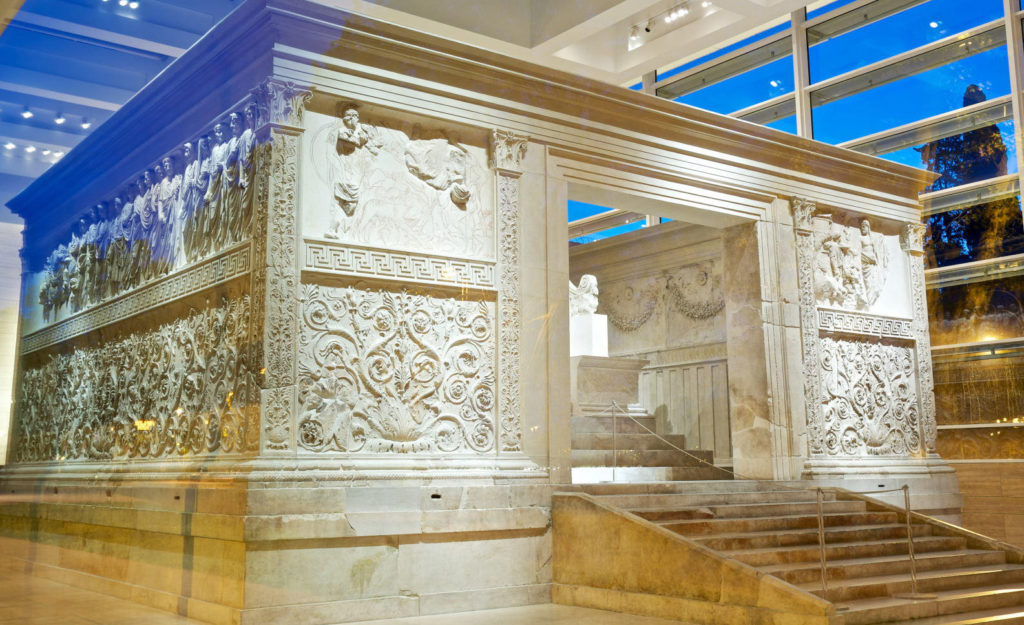On this July 4th, while we celebrate the most patriotic of holidays, I recall this day on a foreign shore in 1987 honoring the cultural taproot of our American republic. I wasn’t gazing on the Magna Carta in the British Library, or upon the Parthenon in Athens. I was in Rome standing before the Altar of Augustan Peace (Ara Pacis Augustae), with an ancient scene chiseled in stone of a ceremony on that very day exactly 2,000 years before my visit.

The Altar is not a big tourist attraction, having only been unearthed and presented to the world in 1938. It was created by order of the Roman Senate in 13 B.C. to celebrate the end of Republican Rome’s fratricidal civil wars and the start of the Pax Romana (Roman Peace) under its first emperor Caesar Augustus. Britannia hadn’t been conquered yet, but Roman law, the social equality of women, secular government, and free thought were already spreading from Italy and Greece to the far corners of the empire. It is doubtful that Greek genius would have survived had our classical forebears not defended it from Germanic hordes and Middle Eastern fanaticism. Magna Carta, that iconic root of our own Republic, is written in Latin – indicative of England’s own debt to Italy.
Two millennia ago, a ceremony to lay the cornerstone of the pagan Altar was held on July 4th. An artist sketched the figures of Augustus, his extended family, senators, and pagan priests all gathered on that day. The artist and his apprentices later brought those individuals to life as 3-dimensional sculptures adorning the walls that enclose the Altar – a panorama for posterity. It took four years to complete and prepare the Altar for its first animal sacrifice. Romans believed in reality art, and sure enough, a clearly impatient child is tugging on a man’s toga as another child looks on as they endure the boring ceremony (photo below).

Our Institute was launched in 1987 with that visit to Rome on July 4th. Our unique mission was to find the deeper roots of Italian culture. The year 13 B.C. and the Altar of Peace was a milestone in our legacy. It was the culmination of two centuries in which today’s Italy was first unified politically (222 B.C.) and then made one, culturally – Latin became the standard language and all Italians (Italici) shared Roman citizenship. Moreover, Augustus insured that Italy would reap the benefits of empire – it wasn’t an easy accomplishment.
Before the Senate anointed him as Augustus, he was Octavian, nephew and adopted son of Julius Caesar. After Caesar’s assassination, Octavian formed an alliance with Mark Anthony to hunt down his father’s murderers, which they did. Then, Anthony famously fell for Queen Cleopatra of Egypt and divorced Octavian’s sister. Anthony wanted to divide the empire, east and west, with Octavian. Anthony would rule the wealthy east with Cleopatra, and Octavian would keep the semi-barbaric west. Anthony’s plan would deny Italy precious taxes and tributes from the east and ultimately weaken it. Furthermore, Octavian and the Roman Senate feared that Anthony’s rival empire would become another Carthage that could destroy Italy.
In 31 B.C., Octavian’s Italian fleet defeated Anthony’s Asian fleet at Actium (off the coast of Greece). Anthony and Cleopatra fled and later committed suicide. Octavian subsequently spent years reuniting the empire – east and west – and completing the pacification of Gaul and Spain. Upon his triumphant return to Rome, the Altar was consecrated. Italy’s future was now secure. All the talent and wealth of the empire now flowed to Italy for the next three hundred years.
If you want to know why Italy has been the center of the Western World for millennia and the font of art, music, science, academia, sport, exploration, business, innovation, and religion, then look no further than the Altar of Augustan Peace.
Is it just a coincidence that July 4th connects two great historical events? -JLM

Congratulations and Happy Anniversary to the Institute and all those involved in keeping the Classical Heritage alive.
Steve Aiello